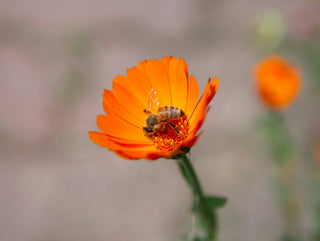Calendula Officinalis is one of the most beautiful, useful, bee-loving and healing flowers ever grown. Although it is thought of as an annual it has the properties of a perennial plant, it’s just that in colder temperatures it will die off in winter. The plant should never be mistaken for the Marigold species called Tagetes.
A bit of history
Calendula Officinalis was originally used by the Romans as a medicine and they also added it to food for colour and for its wonderful healing powers.
The name 'calendula' came about because it was usually seen to bloom on the first day of the month. The flower has always been considered a symbol of happiness. The plant has its place in history, myth, magic and folklore and is still used today to make vibrant coloured garlands for Indian weddings.
Calendula has been used over the centuries in many countries in Europe and some parts of Asia as a healing plant. The name we all know it as ‘pot marigold’ comes from Germany where it was used to add to the pot for soups and stews and was used to colour butter and cheese, which is a really interesting idea. Nowadays the petals are commonly used for interest and flavour in salads.
However, they don’t only look beautiful but they are really good for the digestive system too. They taste wonderful with some peppery nasturtium leaves so roll on summer so we can enjoy them!
Healing properties
What is so interesting to us today about its history is that it is still a powerful healing plant and scientifically today we know a great deal more about its healing properties.
The flowers are the medicinal part of the plant. Here are some of the ways the flowers can be useful
- Calendula can help soothe and reduce pain
- It’s a good anti-inflammatory (arthritic joints)
- Good for sprained muscles, swelling from injuries and bruises
- Varicose veins, leg ulcers and chilblains
- Can stop bleeding and is really good for scars and burns
Calendula is antiseptic, antiviral, antibacterial and anti fungal. It can detoxify and heal wounds, and is good menstrual regulator.
The flowers are made into:
- Ointments and creams
- Poultices
- Diffused oils
- Extracts
- Tinctures
- Infusions
- Fresh petals
Scientists are continually learning about the benefits and the power of plants and some recent research and evidence talks about calendula being very helpful with post chemotherapy and radiotherapy skin. The natural option is always a good choice for your skin.
Our Calendula Cream is a huge favourite with our customers. It is used for a wide range of symptoms including eczema prone skin. It is a natural plant-inspired cream, fragrance free, parabens free, and aside from any other uses it is the most wonderful soothing deeply nourishing moisturiser for the skin. I especially like to travel with it because it is great for all over the body including the face and is useful for calming sunburn too.
 It’s time to get sowing seeds again and it will soon be the perfect time to sow calendula for your own health and wellbeing. The seeds can be sown from early spring ready for outdoor sowing after heavy frost has passed. The seedlings take 5 to 15 days to germinate so it’s not long to wait to see them. They like a rich soil and sunny areas but will also grow quite happily in partial shade.
It’s time to get sowing seeds again and it will soon be the perfect time to sow calendula for your own health and wellbeing. The seeds can be sown from early spring ready for outdoor sowing after heavy frost has passed. The seedlings take 5 to 15 days to germinate so it’s not long to wait to see them. They like a rich soil and sunny areas but will also grow quite happily in partial shade.
And when they are in full bloom here’s how to make your own Calendula hand balm.
How to make your own Calendula balm:
- Dry a cupful of Calendula petals and add a cupful of light oil (coconut, olive or almond are good)
- Leave to infuse for 2-3 weeks and then strain.
- Gently heat the calendula oil in a double boiler and add some grated beeswax ( ask a local beekeeper for some), melt and pour into tins and leave to cool.

